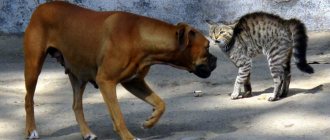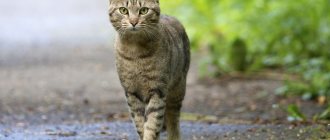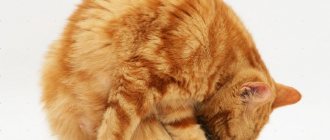People who have cats as beloved pets derive incredible emotional pleasure from interacting with these highly organized, complex creatures with developed sensuality. Pets themselves are also no strangers to emotional outbursts and discharges, which can be caused by contact with their fellow animals, communication with people, as well as…..catnip or catnip.
The article will discuss the main issues related to the possible use of this plant in the life of cats, its effects on them, as well as common features of use.
Photo 1 shows what cats' favorite catnip, often simply called catnip, looks like.
Flowers are the remains of heaven on Earth. Blooming catnip is no exception
Description and properties of the plant
A responsible owner approaches any decision regarding his pet carefully. In this case, we should start by answering the question: catnip - what is this miraculous plant?
So, the so-called catnip is a perennial plant of the Lamiaceae family. Before its cultivation began in Europe, it grew in the countries of North Africa and the Mediterranean. This plant is also known as mint catnip and catnip. For those interested in scientific names, the Latin name for catnip is Népeta catária. The plant has diverse properties:
- tonic
- antipyretic
- anti-inflammatory
- painkillers
- sweatshops
- antitussives
- anthelmintic
- choleretic
It's a pity that there are no mint trees...
Next, you should understand how catnip acts on cats in most cases.
Effect of mint on cats
The mechanism of action of catnip on cats is interesting. When a cat inhales the essential oils contained in catnip through the nose, this is a signal to the hypothalamus of the brain, which forms an interesting behavioral reaction of the animal. Nepatalactone (the essential oil in mint) is detected by the cat's smell; its effect is comparable to the effect of a mating pheromone on a cat.
Cat brain
Inhaling nepatalactone stimulates some cats to playfulness, while others, on the contrary, relaxes them, the cat concentrates on one point. This condition lasts from 5 to 15 minutes, and only after 2-3 hours is a second reaction possible after a new inhalation. According to veterinary statistics, approximately a third of sexually mature cats experience excitement from inhaling mint essential oils.
Example of a calm cat reaction to nepetalactone
As a rule, cats and cats that have not reached puberty remain indifferent to the effects of catnip on them. Why do they need it?
Not ready for mint!
(the image on the container does not correspond to reality - the product is “addressed” to individuals aged 6-7 months, kittens do not need it)
This is where I belong at my age, and not on your jar...
What are the benefits of this unique plant?
It can be argued that catnip is an animal behavior corrector . For example, aggressive pets who consume the plant turn into affectionate and cute ones. In turn, lazy and calm cats turn into active and playful pets. In addition, the plant can affect cats in the following ways:
- after eating mint, it turns out that it has a bactericidal effect, relieving cramps in the animal’s stomach;
- according to veterinarians, catnip is considered an anti-stress drug that helps the animal calmly endure moving or other situations that cause stress in the cat;
- the grass is not a strong narcotic substance and therefore the animal does not get used to it with rare and controlled use of mint;
- if the animal does not want to eat, mint added to food in dried or fresh form causes appetite;
- the plant can be used as an anthelmintic.
After the popularization of catnip among pets, many companies began producing cat products infused with the plant's aroma. And some breeders independently made toys containing dried grass leaves. They also began to produce special drops that teach the cat to sharpen its claws in a certain place, which is sprayed with an essence with the aroma of catnip. This allows you to wean the animal from damaging upholstered furniture.
The advantage of the plant is that it can be easily grown in a flower pot on a windowsill that is constantly illuminated by sunlight. In this case, the plant does not need to be watered frequently, and the soil should contain a minimum amount of acid-containing substances . To prevent the cat from being tempted to eat the flower, after it ripens, the mint is picked, crushed and dried. The cat drug should be stored in a place inaccessible to the animal.
In addition to the fact that the plant is favored by cats, it is very popular with bees, who are attracted by the nectar of mint flowers. The plant is also used in the manufacture of vermouth, soap, perfume and other cosmetics. Plus, the plant has medicinal properties that help improve stomach function, soothe migraines and eliminate coughs. It also improves blood circulation and helps cleanse the lungs and combat lack of sleep. And in addition, a plant in a flowerpot on the windowsill will repel mosquitoes .
The benefits and harms of mint for cats
Unlike valerian, mint does not cause addiction, nor does it cause seizures, hallucinations and other disorders of the cardiovascular and digestive systems. Catnip is needed, first of all, for
to help correct the cat’s behavior - to accustom it to something, to make travel easier (to relieve stress).
Harm can be caused to the animal; if catnip is eaten, it will cause stomach upset. The smell of peppermint (nepetaloctone) is comparable to the effects of marijuana and LSD, and uses the same biochemical pathways in the brain. As a reflex suppressor, catnip, if used excessively, will thin the cat's nervous system and reduce the animal's reaction.
Cheer your cat up!
It should be noted that there is also a scientific approach to the issue of studying the effect of catnip on the cat’s body. In the early 2000s, this was done in the UK by scientists from the universities of Belfast and Lincoln. They set the task: to study the reactions of cats to various stimuli (the number of animals participating in the experiment was several dozen). For this purpose, cats were offered three different scents - pieces of cotton fabric soaked in the body odor of a domestic rabbit, catnip and lavender. Surprisingly, the smell of rabbit lost out to mint. The most striking cat reaction was caused by the fabric soaked in catnip. The cats did not let go of these scraps of fabric from their paws for a long time and became playful and active. The researchers also noted the fact that the effect produced by the smell weakens over time as cats gradually become accustomed to it. Scientists have come to the conclusion that a constant change of smell is important for pussies to live comfortably, which, in turn, dictates that owners need to take care of providing the animal with a place where the cat can easily breathe fresh air and accumulate olfactory impressions.
When not to use mint
There are situations where mint, despite its benefits, can be harmful. That is why, before giving catnip to your pet, you should familiarize yourself with the list of contraindications for use.
Under no circumstances should you give the herbaceous plant:
- pregnant cats;
- nursing cats.
This category of furry pets is easily overstimulated, so mint can cause serious stress to the cat. Such an emotional state depletes the nervous system. In addition, you should wisely give a sedative herb to your cat when its use is appropriate and will not lead to disruption of the activity and mental state of the tailed cat.
Is catnip safe for animals?
The harmlessness of mint is due only to the cat's temporary dependence on enjoying the smell of the plant. A cat, under no circumstances, will inhale incense for days on end.
Experts recommend giving catnip to animals with a high degree of aggression with caution.
Excessive overexcitation of the nervous system of an already aggressive animal can provoke:
- throwing a cat at other animals;
- aggressive attitude towards children and adults;
- room marks.
Under no circumstances should you offer grass to an animal every day.
Varieties of catnip
There are more than 250 varieties of nepeta. The most common of them:
Catnip (nepeta cataria), reaching a height of more than 1 meter;
Lemon catnip (nepeta cataria var.citriodora);
Catnip grandiflora (nepeta granfiflora);
Catnip semi-sedentary - the most beautiful (nepeta subsessilis);
Nepeta subsessilis: gives pleasure to both eyes and noses….
A person has 5 million nerve endings in their nose, while a cat has about 19 million. Therefore, the common belief that cats have a weak sense of smell is erroneous.
Siberian catnip - (nepeta sibirica), not inferior in beauty to the previous one, but growing worse;
Fassen's catnip (nepeta faassenii) - especially popular in Europe;
Musin's catnip (nepeta mussinii) is a mountain species, including the Transcaucasian catnip - nepeta transcaucasica.
Practical purposes of application
Catnip is used to tame a cat to a sleeping place (finely chopped mint is sprinkled on the cat's bed, on a diaper in a cat carrier, etc.), to the toilet, scratching post (a special spray containing essential oils is sprayed onto it). catnip oil). To stimulate physical activity, toys are given that contain catnip (mouse, etc.). In addition, catnip copes well with cat stomach problems and can help restore appetite. It also has bactericidal properties (kills worms).
When the mint season ends...
Drugs
The number of preparations with catnip is impressive. These include tablets, capsules, dietary supplements, sprays and medications for cats. Their scope is different, as is their composition. Although the main element is catnip, other components are added to it, which create different effects. Mostly tablets and drops are considered common for use. And most of all, feed additives are purchased for animals.
Pills
Catnip-based tablets are mainly used to normalize sleep, eliminate insomnia and relieve stress. One of the best products on IHerb is Mason Natural Calming Sleep Tablets. Usually there are 90 tablets in a jar. The company that created it was founded in 1967, and the drug has undergone all kinds of research. It contains no soy, and in addition to improving and maintaining healthy sleep, can be used as a dietary supplement for normal digestion.
Mason Natural, Calm & Restful Sleep, 90 Tablets
390 ₽
Buy at a discount
Catnip is not only suitable for use by adults. Tablets have been developed that have a calming effect on children. Planetart Herbals – 150 tablets formulated by Dr. Michael Tierra. The drug not only calms the child, but also helps to increase concentration.
Planetary Herbals, Calming for Children, 440 mg, 150 Tablets
935 ₽
Buy at a discount
Drops
Drops are also divided into preparations for adults and children. For the most part, this is a tasty remedy for improving digestion, reducing heaviness and bloating, but there are drops for relaxation and improved sleep. The drug effectively copes with acute pain in the stomach and intestines. Relieves insomnia and helps align sleep patterns. Also helps in treating occasional digestive disorders. For children, the best option would be Gaia Kids drops.
Gaia Herbs, Kids, Belly Tonic, Chamomile, 1 fl oz (30 ml)
770 ₽
Buy at a discount
Adults can purchase Relaxing Sleep for calm and relaxation.
Herb Pharm, Relaxed Sleep Toner, 1 fl oz (29.6 ml)
980 ₽
Buy at a discount
Medicines for cats
The list of products based on catnip is different because it can be used to achieve different effects. Flavoring additives and feed are common.
Pet Naturals flavor contains live cultures and is suitable for cats of all ages, breeds and sizes. Helps the digestive system and improves immunity. It does not contain any chemical components and does not contain wheat or corn. Is an active probiotic for daily use.
Pet Naturals of Vermont, Daily Probiotic, for Cats, 30 Chewable Tablets, 1.27 oz (36 g)
440 ₽
Buy at a discount
Freeze-dried salmon treat contains catnip. Suitable for both cats and dogs. Does not contain chemical additives or preservatives. The drug can be crushed into food to improve appetite and restore the digestive system.
Why doesn't my cat react to catnip?
Between 50 and 75% of cats are affected by catnip. Various reactions to the use of catnip, as well as their complete absence, is a hereditary trait - the cat simply does not have responsive receptors. So, for example, mint has practically no effect on Siamese cats.
Indicative photo: Siamese cats do not react to mint, they are interested in other plants.....
Where to buy lemon catnip?
Lemon catnip (nepeta cataria var.citriodora) is a branched perennial plant with a pleasant lemon aroma, shaded by the smells of mint and geranium. Its leaves, inflorescences and stems are removed during the period of mass flowering and dried under a canopy.
Catnip is sold in pet stores and veterinary pharmacies, usually in the form of a spray, the volume of which varies from 10 to 150 ml. A spray with a volume of 10 ml has an average price of 40-45 rubles.
A ready-made tincture of catnip in alcohol, which has a wide spectrum of action, can also be purchased at the pharmacy. The use of this “human” version of catnip for “feline” purposes requires consultation with a veterinarian.
Catnip tincture, sold in a pharmacy
Growing catnip at home
Catnip is grown by sowing seeds in a box in late winter or early spring. Cover with film and place in a warm place. The first leaves that appear are transplanted into pots and placed in a cool place so that they do not stretch, then put back in the heat. The plant is planted when 3-4 large leaves appear on it.
Regular, measured watering is required; you can use trays for this. Leaves and shoots are formed by cutting from the sides. It is necessary to use fertilizing in the form of mineral fertilizers.
And they said that you would grow mint for me...
Storing mint
Catnip is not very susceptible to disease. It is collected in the morning, before the flower buds open (to ensure an abundance of essential oils), cutting off the stems and leaves, and washing. The cat is given it both fresh and dried.
A third of the cats on the globe would subscribe to this advertising slogan on the packaging of dried mint.
To dry it, several stems are hung up and the leaves are dried in a bowl.
It is recommended to store mint in a closed jar, in a cool place, away from cats. The description of storage rules should be carefully read when purchasing the product at a veterinary store/pharmacy.
- The following are made from dried mint raw materials:
- Powder
- Spray
- Bubble
- Pressed balls
- Catnip extracts
Mint as a means of education
The plant can be used as a reward for training. For animal games, you can use toys bought at the pet market or sewn, knitted with your own hands, filled with dried mint. Even the most mischievous animals will be attracted to them more than the dubious pleasure of hanging on the curtains.
For small kittens, you can buy catnip spray. The scratching posts treated by him immediately make you understand where you can treat your claws. Furniture, wallpaper and carpets in problem areas can be rubbed with grass or treated with a spray.
Veterinarian advice
Since pheromones, sprayed at the right time and in the right place, significantly improve the cat’s emotional status and are able to correct the animal’s unacceptable behavior, veterinarians advise trying the effects of catnip to resolve problematic situations. One should not expect unequivocally positive results from the influence of catnip, since its effect is individual in nature. And, of course, for visits to veterinarians to minimize the stress of the animal, veterinarians can also recommend this remedy!
Flehmen is the name given to a cat's grimace when it perceives pheromones. Characterized by an open mouth, raised upper lip and tongue mobility
Conclusion
A key element of feline social behavior is chemical communication. Owners of these pets need to take this circumstance into account. Before introducing a cat into a new society, you need to present him with samples of the smells of this place and then the tactic of spraying mint will be useful. This will reduce the stress that is inevitable when changing the environment. Smells, especially natural ones, can and should be used to “olfactory” enrich the cat’s space, especially if the animal mainly stays within four walls.
I'll wait for the mint season...
Understanding how different chemical signals affect the behavior of cats and their personal well-being will help improve the relationship between humans and their pets, making their stay in the home more pleasant and safe. And the more comfortable the animal is, the more decent it will behave, and the easier it will be to get along with it. Thus, having the owner know about catnip and what it can be used for is a necessity.
Contraindications
Cats are naturally endowed with the ability to recognize which grass they can take and in what quantity. However, the owner is responsible for the pet. Therefore, you should not rely on the animal’s intuition if:
- the cat is pregnant;
- the pet reacts too violently to the action of catnip. In this case, excessive consumption of grass can deplete the animal's nervous system. A violent reaction should be understood as agitated behavior of the cat for more than half an hour with excessive physical activity.
In these cases, you should limit your pet's access to catnip. There are no other contraindications to taking catnip. But, if there are several cats in one house, and among them there is a male, it must be taken into account that under the influence of the plant he can become aggressive. Therefore, cats can only be given catnip separately from cats.











